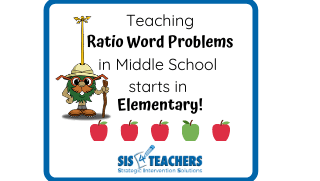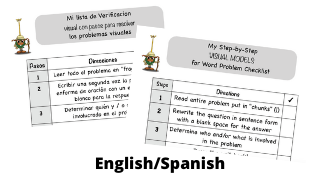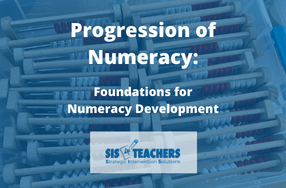As students move into middle school, they’ll need those word problem skills you’re teaching them right now in elementary school!

This is a theme for me this week as I’ve been helping my son, Connor (now in 6th grade), with his math. I watched him on his journey through elementary math, and I’ve been able to help with all kinds of things, but this week solidified for me the importance of the vertical approach to math strategies that we teach at SIS4Teachers in our Molding Math Mindsets training. I got to see, first-hand, that when students don’t have the benefit of a framework, or a vertical zip, in a school district, they might end up having holes in their math comprehension as they get older.
Model drawings, visual models, bar models, unit bars – by now you know this is one of my most favorite ways to teach kids how to do word problems. Understanding this whole approach helps relate back to the concepts that students should be learning to help them develop algebraic understanding.
My Personal Middle School Case Study
The high school where we live has 7000 kids, and our middle schools are large as well, so we are still 100% virtual learning due to COVID (though we hope to be able to go back in-person in the second semester!). Both of my children are doing online learning at home, and I’ve been able to watch my kids’ teachers work their tails off, as all teachers are right now, to help make accommodations for what we’re facing with COVID.
It’s been a rare opportunity to be there with my son Connor as he’s learning math concepts in sixth grade, and it’s really helped me to diagnostically see where misconceptions of students’ mathematical understanding can really come to the forefront as they get older.
In elementary school, Connor did really well. He was able to keep up with most of the math concepts, but there was never really a connection of the concepts being taught from one grade level to the next, there was never a common language, which is one of the things we at SIS4Teachers think is so vital.
I made a connection today while helping Connor with his homework. As he was reading the story problems, I immediately knew they were working on ratios, but he was really struggling with some misconceptions. I realized that, if Connor had had a series of multiplicative comparison understanding when he was in 4th and 5th grade, and if he really understood the step-by-step visual model process, this concept of ratios would have been a piece of cake.
Building a Foundation of Problem Solving Early
If we teach kids this early on in first grade, imagine Connor having that process reinforced year after year after year. Imagine him being able to independently use this process on tests to help him apply his learning. That’s something that Connor didn’t get in his school because they didn’t really have a cohesive way of doing word problems, there wasn’t really an adopted way to help students do this. And although he did fine in elementary math, we can see that the work that we’re doing in elementary will make a difference for students as they get older.
I’ve gone into 6th grade classrooms where students have grown up in their school system. They do visual models religiously with the journal that’s coded. Everyone uses a common language, whether you’re in 2nd grade, 3rd grade, 4th grade, or 5th grade, you learn the step-by-step model. As problems start to become harder, students are able to rely on this process as a way that can help them problem solve through different types of problems. I’ve watched these sixth graders say things like, “These ratio problems are so simple!” because they have the foundation of word problems and understand the concept of multiplicative comparison.
Today, we are featuring our Model Drawing video tutorial, and PowerPoint companion for multiplicative comparison so you can see how ratio problems are similar. If kids could learn this process of reading the problem, it would be simple for them too!
As you’ll see in the video, we use one inch square tiles to help students understand this concept. Quite frankly, that’s what Connor needed to help with his homework this week so he could understand what the words were saying.
The First Step: Slow Down

One of Connor’s biggest problems was that it was difficult for him to not just plow through the problem and want to know exactly what the answer was, because that’s what most kids do. I had to force him to slow down and “chunk and check” a problem. As soon as he heard the ratio, I had him just stop for a minute – not think about the total, but to think about how many dark chocolates were there compared to white chocolates? How many green apples were there to red apples?
He had 12 or so word problems for homework, and he felt like he’d never get through because he didn’t understand the concept! But as soon as he agreed to my pace (SLOW!) it seemed to start to click. He put in his labels (white chocolate/dark chocolate, green apples/red apples), and then had to figure out how many one inch square tiles we would need to create the ratio. He needed to look at the details – were they talking about the ratio for comparison of green apples first? Or red apples first? That’s what the chunking and checking process is really about. (It’s also the first step in our Step-by-Step Visual Models Checklist! Download it here for free!)
As Connor continued to read the problem, I wanted him to think about where that total went. The total they give you – was it for the red apples? Was it for the green apples? Was that the white chocolate? Or was it the dark chocolate? Was it the white and dark chocolate combined? I needed him to understand, once he knew where those one inch square should go, where the total would go.

Connor can do simple division, and we know that ratios aren’t anything really hard in math, but when it’s applied in a word problem, kids panic because they don’t really know what to do with ratios.
He kept working through the problem. He told me, “There’s 7 total containers – 5 red and 2 green. I know there are 45 red apples total, so I’m going to divide – take the 45 divided by 5 boxes so then I know that each box is equal to 9.” So, then as he was figuring out how many green apples there were, two boxes worth, he said, “each of those boxes are equal, so there must be 18 green apples.” It was almost like a lightbulb going off! He realized what the problem was asking and really understood how simple it was!
Sometimes, the problem might ask a different question – something like How many total apples are there? Well now that Connor realized how much each unit bar was worth, he could figure that out pretty easily as well.
The Visual Model Process – It’s SO Worth It!
It just hit me – with all the work that we put in to help kids learn this process – IT IS FOR A REASON!! So many teachers say, “I don’t want to do the area model with partial products. I just wanna teach partial products because middle school just needs to do the traditional way so we’re just gonna do that.” I hear that a lot. But when kids get to polynomials and X becomes a value, it does matter if they understand the area model has partial products!
It’s the same thing with word problems. If kids went through the word problem process that we’ve talked about in past blogs, that we have in our store with our book, poster and Model Drawing Bundles, with the Bundles you have access to in the M3 Membership Library, if they understood the basics of part-whole addition, part-whole subtraction, part-whole missing addend, part-whole multiplication and division, and were able to do multi step, if they understood the idea of additive comparison, and the power of what we call multiplicative comparison, as they turn that corner in fourth to fifth grade into middle school, it IS going to stick so they can understand ratios and rates.

Step-by-Step Model Drawing, by Char Forsten, is a really great resource to use if you’re a sixth grade teacher. We also have an advanced model drawing book that takes these algebraic concepts to a higher level for older students. I also love our sixth grade model drawing book, because it’s filled with all of these things with fractions and decimals and ratios and rates – all the things that Connor is going to be learning this year.
Of course, I will continue to serve as Connor’s “virtual home para-pro” and help reinforce these concepts so he can understand math in a conceptual way, even if it might not be taught that way. It might not be being taught that way because we may assume that kids have these conceptual understandings, but we have to realize that math is all connected. When we look at schools today, it’s not about making sure each individual teacher has the same book purchased from the same publisher. It’s more about applying the strategies, which is where the Math Mights come in – can kids use D.C. with 8 + 5? And 0.8 + 0.5 =? It’s more about having concrete tools available with the Math Salad Bar – whether it’s virtual or physical. Get the Virtual Math Salad Bar template!
As kids rely on the consistency of a common language in a school district, we have to include a common language for visual models.
As I worked with Connor, struggling to understand ratios, it was powerful for me as an educator and as a parent, to be able to unlock that understanding for him and to watch him to start to look at the ideas of word problems differently.
One of the things he noticed was that he was really solving for X. We wrote the algebraic equation on the side a few times because I know what’s coming up next! We’re going to start to have x and y for numbers and algebra tiles are going to be needed – good thing I have some downstairs in our warehouse to help him!
As elementary teachers, sometimes we think about all the work we’re doing to help students get better, and unless you have a K-8 building, you don’t get to see the pay off of what happens in 6th, 7th, 8th grade.

So, for all the elementary teachers doing our application journals, using our videos, really trying to diligently implement visual models – realize that your work is really laying a foundation for students to really have the understanding of math comprehension. It’s important, and it’s worth it.
For middle school teachers, check out thinkingblocks.com, part of Math Playground. It has a whole section for ratios and proportions that can help students to understand this concept visually. I certainly am going to have Connor use it to practice more of these this week!





